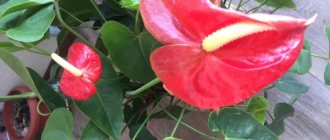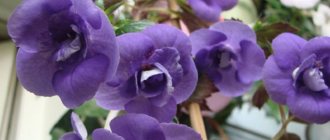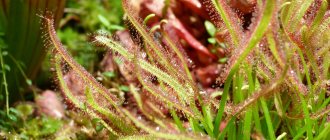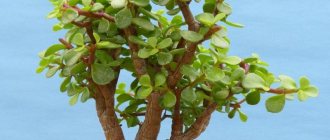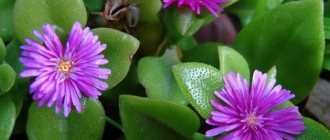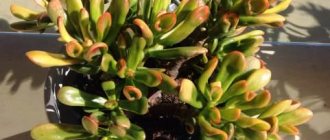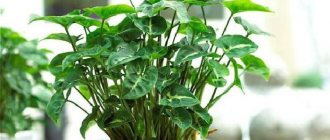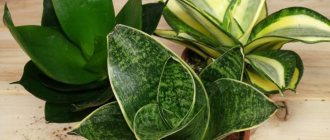Echeveria (Echeveria) or stone rose is a succulent, a representative of the large Crassulaceae family. Named after the artist Atanasio Echeverría Coda, who illustrated stories about Mexican vegetation.
This plant attracts the attention of flower lovers with its unpretentiousness and original appearance, for which it is nicknamed the stone rose. It is represented by a rosette (its diameter ranges from 3 to 40 centimeters), formed by spirally arranged fleshy leaves and resembling a rose. The surface of the leaves is covered with a waxy coating or velvety fluff that protects against moisture evaporation. The leaves can have a variety of colors: green, light green, almost white, burgundy.
In nature, echeveria grows on the plains and mountains of Mexico and Peru, where summers are very hot and winters are warm.
Typically, stone rose blooms in spring and summer, but some varieties delight with abundant and long-lasting (about a month) flowering in the winter months. Bell-shaped flowers (white-cream, lemon, yellow, coral, orange, pink, scarlet) rise on an elongated peduncle reaching 90 centimeters in height. They form inflorescences in the form of panicles or spikelets.
The stone rose in combination with other succulents looks original on an alpine hill.
Botanical description of the plant with photo
Echeveria or Echeveria is a succulent plant belonging to the Crassulaceae family.
The perennial has several distinctive features:
- may be stemless or have a stem reaching a height of 70 cm;
- some species are distinguished by creeping shoots;
- the root system is not buried, but grows superficially;
- in most species, the leaves are quite dense, hard, saturated with moisture, because of this the plant gives the impression of being made of stone;
- the leaf plates are oval in shape with a pointed tip, their length reaches 30 cm, width - 15 cm;
- the color of the leaves is quite varied: violet-pink, wine-red, gray with a blue tint, all shades of green;
- there is pubescence on the leaf blades or a coating similar to frozen wax;
- the rosette in which the leaves are collected can be dense or loose;
- The peduncle can be lateral or vertical and reach a height of up to 50 cm;
- the color of the peduncle depends on the light: in bright light it is red-orange, in dim light it is yellow;
- the flowers are small (up to 30 mm) five-membered bells, collected in erect inflorescences.
Reviews from flower growers
My flowers are all on the windowsill, which is located on the sunny side and not all flowers survive there.
Today all that remains are the Crassula, a couple of geraniums, mother-in-law's tongue and cacti. Caring for it (Echeveria - editor's note) is minimal, water it and occasionally loosen the soil. It is growing at a good speed and I think in a month or two it will be necessary to transplant it into a larger pot. Today I already have three plants, two are currently blooming, one is a baby. I bought more while we were in the store, and I don’t regret it at all. Other flowers die, but my echeverias grow and bloom. Idealnaya
https://irecommend.ru/content/krasivaya-i-ne-prikhotlivaya-0
I bought it in January, I have it a little different than on the screensaver: plum color, with a bluish waxy coating, and the shape of the leaves is different.
In summer it is very bright, almost amethyst, but in winter it turns pale. She lived on my eastern window, but there was little light, and as a result my “rose” grew to be 12 cm tall. The spectacle was not very attractive, it began to get more light, the top became denser, but the bottom was still bald and loose. The result was cabbage on a stalk. Smile) And then in April a friend came to see me. I gave the top with 6-7 leaves to this pest, but it was a pity to throw away the stem with 4-5 leaves, so I planted it back in the pot. And she left for a month. I arrive, and there is such a multi-headed monster formed Smile) <…> I like this tree even better. I’ll probably take note of this “barbarism” Smile) Varvara Savelyeva
https://irecommend.ru/content/moi-pyatiglavyi-zmei-gorynych
It always stands in a sunny window, watered as the soil dries.
Doesn't demand anything, doesn't get capricious, doesn't get sick. Over time, my flower turned into a gray-blue cap on a stem, but one day, several years later, she surprised and gathered the whole family around her! Our flower shot out an arrow with the same “dusty” leaves, only sparser. “It started to branch,” we decided, but after a few days “dusty” orange bells appeared on the arrow! With sharp edges and some fabulous golden stamens! We were stunned! And now it blooms constantly! It's been 7 years already!!! And it continues to grow! Any leaf that falls into the ground from it immediately germinates, so there will be no problems with its reproduction!))) A funny, but constantly blooming resident of our windowsill! Love her! ALTAIR_85
https://irecommend.ru/content/pylnaya-lyubimitsa-foto
Indoor varieties of echeveria
Of the 200 existing species of echeveria, a sufficient portion of them grow well at home. Most Popular:
- agave;
- hump-flowered;
- The Pearl of Nuremberg;
- bristly;
- Lau et al.
They all differ in botanical characteristics and color, so many gardeners prefer to grow several varieties at the same time.
Find more information about varieties and hybrid varieties of the plant here.
Origin story
This succulent is native to Mexico. It is also found in the United States and Peru; some species were found in the Caucasus mountains.
Echeveria was first mentioned in scientific works in the 19th century . However, by that time the plant had long spread throughout the world thanks to trade relations. The stone rose was grown in the palaces and gardens of wealthy aristocrats, it was added to the bouquets of court ladies, and used as decoration for dresses, hats, carriages, and so on.
Temperature
Echeveria is a heat-loving plant that thrives even in very hot conditions. During its growth period, room temperature is recommended. Since the flower loves daily temperature changes, the appropriate indicator for it in the daytime is from +22 to +26 °C, at night - from +10 to +16 °C.
In winter, the air temperature in the room with echeveria should be no higher than +13 °C and no lower than +7 °C.
Wintering in cool and dry conditions will have a beneficial effect on bud formation. Otherwise, the absence of a dormant period will significantly weaken the plant.
Mistakes when growing echeveria
Before talking about specific plant signals about poor care, a few warnings should be given to novice gardeners:
- don’t expect a miracle, succulents grow slowly;
- any living plant can die; if that fails, try again;
- Panic is your enemy; there is always some time to correct the mistake.
How Echeveria shows that it is feeling bad:
- stems and leaves turn black - overwatering, cold temperature. The plant should be moved to a warmer room and dried;
- Echeveria stretches out, the rosette becomes loose - lack of lighting. The plant should be illuminated and “dried”;
- the stone rose practically does not develop, the leaves are small - it needs to be watered and fertilized;
- the plant has lost turgor - lack of moisture. If it’s hot, then immediately water it and shade it; if it’s winter, then you can wait. A lack of water during periods of low light will allow the plant to maintain its shape and not stretch out. Large echeverias tolerate drought especially painlessly.
Echeverias have enough vitality to survive temporary difficulties. Good luck with your rock rose breeding!
How often and correctly to water?
Echeveria tolerates drought conditions well and does not like even slight waterlogging of the soil. Therefore, watering is permissible only after the earthen clod has thoroughly dried to 1/3 of its depth. Excess moisture that appears in the pan is immediately removed.
Recommended frequency:
- in spring and summer – once a week;
- in autumn and winter - once a month.
For irrigation, use well-settled or rainwater.
To avoid moisture getting on the leaves, leading to rotting, this procedure is carried out using a watering can with an elongated spout.
What kind of pot is needed to grow a flower?
The container for planting echeveria should be 1.5-2 cm larger than the diameter of the plant itself and have drainage holes. Due to the shallow root system, a low and at the same time wide pot would be an ideal option.
Experienced flower growers recommend purchasing ceramic or clay containers that allow moisture and air to pass through perfectly. When giving preference to plastic products, it is worth remembering their ability to heat up quickly, which negatively affects the condition of the root system.
Priming
Echeveria prefers loose soils with little nutritional value. For planting, you can purchase an industrial composition for succulents or prepare the substrate yourself.
It is recommended to add fine brick chips and river sand to store-bought soil, and crushed charcoal to prevent root rot.
To prepare your own substrate you will need:
- turf soil - 1 part;
- dry clay – 1 part;
- coarse sand – 1 part;
- leaf soil - 2 parts;
- drainage.
Ground cover or creeping succulents
Creeping succulents can grow in any environment. This can be a vertical or horizontal flower bed, the wall of a house, the roof of a building, etc. Ground cover succulents cover the soil very tightly, creating a carpet effect. Groundcover succulents protect an area of weeds, but it is recommended to fence off the area in which creeping and groundcover succulents will grow, as they very quickly occupy vast areas of land. And since the layer of leaves is quite dense, nothing else can simply grow in this area due to lack of water and light.
Sedum (Sedum)
Most often found in meadows and mountain slopes. In landscape design it is used to create rock gardens and alpine slides. It is used for medicinal purposes for disinfection and treatment of scratches and wounds, as a general anesthetic. Most varieties are perennials, but there is also a biennial sedum. It blooms for 5 months, from early summer to mid-October. Finishes blooming with the first frost.
Transplantation after purchase and more
Young plants (under 3 years of age) are replanted once a year, and subsequently once every 3-4 years. The optimal time for this event is spring.
The process includes several stages:
- Place a layer of drainage at the bottom of the prepared container; for this purpose, you can use broken brick, expanded clay or crushed clay shards.
- Fill the drainage layer with substrate and place the flower in the center of the pot.
- Sprinkle fresh soil around the perimeter of the plant, using your fingers to remove any air pockets that form.
- At the final stage, surround the root collar of the echeveria with small pebbles or a layer of coarse river sand to improve the outflow of moisture.
Leave the transplanted plant for 7-10 days in a shaded place.
Conditions for a stone rose in the country
The bizarre appearance scares off some novice gardeners, as they mistakenly believe that such an unusual plant will definitely require special care during the growing process. Due to its unpretentiousness, the succulent is suitable for year-round cultivation in the country. Most varieties are not afraid of frost, and they are not afraid of heat or drought either. If you choose the right place for planting, you can almost forget about the flower.
Juvenile prefers to grow in open, sunny areas. With a lack of lighting, the decorative qualities of the plant deteriorate, as it begins to actively stretch upward. A flower grown in the sun has more intense leaf pigmentation and is smaller in size compared to a plant that was grown in the shade. When planting under trees, there is a high probability that the flowers will die under fallen leaves.
The plant grows well on sandy or rocky soils and does not tolerate stagnant water.
Note! Juveniles are not picky about soil composition and can grow in any soil, but on heavy clay soils it is necessary to provide a good drainage layer to remove excess liquid from the root zone.
Reproduction
In indoor conditions, echeveria can be propagated in almost all available ways.
Sowing seeds
The process of growing from seeds is considered the longest, as it takes up to 3 months.
Seeds for sowing can be purchased at the store or collected yourself. They are scattered over the surface of a flat container filled with a mixture of peat and sand (1:1), lightly pressed down and moistened with a spray bottle. Cover the top with plastic film or glass.
For 15-20 days it is necessary to maintain temperatures of about 25 degrees. When the seeds germinate, the film is removed. The seedlings are transplanted after 2-3 months.
Leaf
Algorithm of actions:
- Cut off a healthy leaf.
- Dry: 14-20 days for a fleshy plate, 2-3 hours for a thin specimen.
- Press the sheet with the cut inward onto the prepared soil.
- Moisten with a spray bottle and cover with film.
- Maintain the temperature in the greenhouse at +25 °C.
As a rule, when breeding using this technology, babies appear in 2-3 weeks.
Rosettes
This method is considered the most effective - echeveria throws out the first flower stalks within a year. Replanting a rooted rosette is recommended after 2 months, or within a year in case of slow plant growth. The algorithm of actions is the same as when rooting a leaf.
How to root with the top?
Typically, rooting with apical cuttings is carried out after the lower leaves have completely fallen off, as a result of which the plant becomes inconspicuous. The planting method is identical to leaf planting. When propagated in this way, the cuttings buried in the soil begin to grow in about 20 days.
Kinds
About 500 species of stone rose are known, but in Russia, due to the climate, only about 50 of them are cultivated. Let's look at the varieties that are most attractive for home cultivation.
Roofing
The most popular type of juvenile in Europe. The flower is formed from spherical rosettes, slightly flattened on top. The diameter of one rosette can vary from 7 to 15 cm. The foliage is fleshy, dense, and the tips are pointed. The color of the leaves is interesting: reddish-brownish with a bronze tint. Flowering is decorative: during this period, the stone rose is strewn with pink flowers.
Caucasian
Also an interesting variety, found naturally in the mountains in southern Russia. The leaves have a greenish tint and are decorated with hard hair along the edges. The flowers are red-violet. It feels great in rocky soil; when growing at home, it needs abundant calcium supplements.
Marble
The succulent has a decorative color with red and green streaks. By winter, sometimes the foliage turns completely red. Flowers with pale red petals have a decorative white rim around the edges.
Russian
Grows in forest and steppe regions of the middle zone and in the south. It has a well-developed fleshy rosette consisting of dense, juicy green leaves. The flowers are yellow.
Diseases and pests
Ignoring the rules of agricultural technology can cause the development of the following diseases:
- dry rot;
- root rot;
- powdery mildew.
When the first signs of disease are detected, the plant is treated with a fungicide.
Echeveria is susceptible to attacks from pests such as:
- root-knot nematode;
- root mealybug;
- mealybug.
To combat harmful insects, the flower is treated with an insecticide.
Possible problems
Often the poor condition of echeveria is caused by non-compliance with the watering regime or improper lighting.
What to do if you are stretched out?
Stretching of a flower indicates a lack of sunlight. The problem can easily be eliminated by moving the pot to a more illuminated place.
Why did you lower the leaves down?
Drooping leaves that have lost their original elasticity indicate dehydration of the soil. In this case, the substrate must be moistened by adding liquid complex fertilizer to the water, and then strictly adhere to the watering regime.
Also, the reason for drooping leaves may be low room temperature or stagnation of water in the root system.
The lower plates fall off and turn yellow
Yellowing and falling of leaves is associated with stagnation of water in the pot. To eliminate the problem, it is recommended to completely replace the soil.
The socket is rotting: how to save it?
If the socket rots, first of all you need to give it a chance to dry. In the future, it is recommended to transplant the plant into another soil, cutting off the damaged lower leaves and fragments of the root system.
Caring for a stone rose in the garden
It is no coincidence that juveniles can so often be found in cemeteries or on the roofs of ancient houses. Without care, provided there is enough light and periodic rainfall, the succulent thrives.
Watering rules and humidity
Water in open ground only during long periods of drought (longer than 2 weeks). If it rained during the week, then it is absolutely not worth watering.
Fertilizing and soil quality
Fertilizing can only be done in spring. For this you can use: an infusion of herbs, as well as diluted mullein. To create optimal conditions for the root system, the soil should contain a little chalk, more sand and a minimum of humus.
Pruning and replanting
The young need pruning only at the end of September. At this time, wilted inflorescences with seeds are removed, as well as rosettes under them that have begun to dry out. Young shoots are removed only to give the curtain a suitable size and shape. It is best to replant in May, if necessary.
Features of wintering a flower
Without any shelter, the young overwinter in open ground if there is snow cover over it. If there is no snow, then the clearing should be covered with spruce branches or agrotextiles. No protective measures need to be taken if in winter the temperature does not drop below −20 °C.
How to create a mix composition?
The process of creating a composition with echeveria includes several manipulations:
- Choose a suitable container.
- Lay out in successive layers:
- drainage expanded clay;
- soil diluted with vermiculite/perlite;
- moss.
- Arrange the succulent cuttings so that there is room for further growth.
- Lay out decorative elements: pebbles, shells, figurines, etc.
- Water without allowing water to get on the leaves of the plant.
When creating a mix composition, it is important to use succulents with similar habitat requirements.
